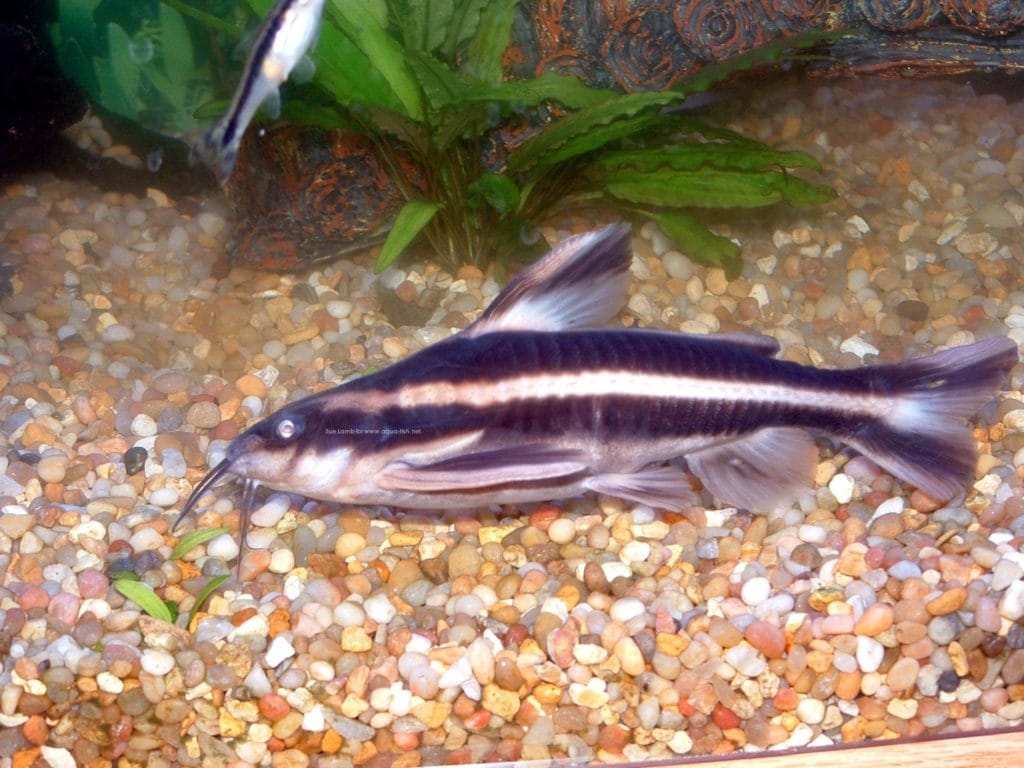Ever seen a catfish that looks like it’s wearing armor? Meet the striped raphael catfish! These South American natives, sometimes called talking catfish, are a popular choice for aquarium enthusiasts. They’re a bit mysterious with their nocturnal habits and unique looks. This guide covers everything you need to know about caring for these captivating creatures. So, if you’re thinking about bringing one of these cool catfish home, or are just curious, keep reading!
Striking Stripes and a Whiskered Wonder
The striped raphael catfish (Platydoras armatulus) is a fascinating creature with a personality as unique as its appearance. Also known as the talking catfish, chocolate doradid, or thorny catfish, this South American native hails from the Amazon, Orinoco, and Paraguay-Paraná river basins. Picture a small, armored submarine, about six inches long, cruising through your aquarium – that’s the striped raphael catfish in a nutshell. While six inches is typical, they can grow even larger, potentially reaching 9-10 inches in optimal conditions. Their striking black and white stripes aren’t just for show; they’re part of a system of bony plates called scutes, providing natural armor.
Raphael’s Ideal Residence: Tank Setup
Creating a comfortable home for your striped raphael catfish is crucial. A 30-gallon tank is the absolute minimum for a single fish, and significantly larger tanks (55+ gallons) are recommended for multiple catfish to avoid territorial disputes and encourage growth. They’re adaptable to water conditions, preferring slightly acidic to neutral water (pH 6.0-7.5) and a temperature range of 72-82°F (22-28°C). A soft, sandy bottom or fine gravel is ideal for their sensitive whiskers. Don’t forget driftwood, caves, and lush plants! These provide essential hiding spots, especially important during the day as they are nocturnal.
Dining with Raphael: Diet and Feeding
Feeding your striped raphael catfish is about understanding their dietary needs. These omnivores enjoy a varied menu. High-quality sinking pellets form the foundation, but supplement with live or frozen bloodworms, brine shrimp, and even some vegetables for a well-rounded diet. Feeding them once a day is usually sufficient, offering only what they can consume in a few minutes.
Decoding Raphael’s Behavior and Sounds
Striped raphael catfish are generally peaceful but can be territorial, especially with others of their own kind. They possess an unusual talent: they can “talk”! By rubbing their pectoral spines against their bodies and using their swim bladder, they produce a unique croaking sound. The exact purpose of this sound is still debated, with theories ranging from communication to defense. Some experts believe it may be related to courtship or territorial displays, while others suggest it’s a warning signal. Research is ongoing to fully understand this fascinating behavior.
Compatible Companions: Choosing Tank Mates
Creating a thriving community tank involves carefully selecting compatible tank mates. Peaceful, similarly-sized fish are generally suitable, but avoid tiny fish, which might become a meal. Aggressive or fin-nipping species are also not recommended, as they can stress your catfish. Researching potential tank mates is crucial for a harmonious environment. Good options often include certain tetras, some Corydoras catfish species, and peaceful loaches. Larger, more robust fish, such as Congo tetras or some peaceful cichlids, can also coexist peacefully. Avoid housing with bichirs, as mentioned in the provided text, due to potential conflicts.
Breeding Raphael Catfish: A Challenge
Breeding striped raphael catfish in a home aquarium is challenging, rarely achieved by hobbyists. While possible, it requires a deep understanding of their breeding requirements and significant patience. Replicating natural breeding triggers, including specific water parameters and seasonal cues, is key. Some breeders have reported success using hormonal injections, an advanced technique only for experienced individuals. Extensive research and expert consultation are recommended for those considering breeding.
Maintaining Raphael’s Health
Striped raphael catfish are generally hardy but not immune to illness. Excellent water quality is paramount for disease prevention. Regular water changes, reliable filtration, and a balanced diet are crucial. Monitor for unusual behavior or appearance, such as lethargy, loss of appetite, or visible signs of disease. Consult an aquatic veterinarian for any concerns.
Tips for a Thriving Raphael
- Hide and Seek Champions: Ample hiding places, like caves and dense vegetation, are essential.
- Water Quality is King: Pristine water conditions are crucial for health and happiness.
- Foodie Fun: A varied diet keeps them interested and ensures proper nutrition.
- Behavioral Clues: Monitor their behavior; changes can indicate problems.
- Patience is Key: They can be shy initially, but will eventually become more comfortable.
Are Striped Raphael Catfish Aggressive?
The question of whether striped Raphael catfish are aggressive is a common one, often stemming from misconceptions about their behavior. While they can display territoriality, particularly in overcrowded conditions or with unsuitable tank mates, labeling them as inherently aggressive is inaccurate.
Their shy, nocturnal nature often leads to misinterpretations. During the day, they frequently seek refuge in caves or under décor, a behavior sometimes mistaken for aggression. In reality, it simply reflects their preference for a secure, dimly lit environment. They become more active at night, engaging in their natural scavenging behaviors.
While generally peaceful towards other species, their predatory instincts mean careful tank mate selection is crucial. Tiny tank mates might be viewed as food, not friends. Choose peaceful, similarly-sized companions that won’t trigger their territorial instincts.
Providing ample space and appropriate décor, such as caves, driftwood, and dense plants, minimizes the likelihood of territorial displays. These elements replicate their natural environment, offering security and reducing stress.
So, are striped Raphael catfish aggressive? The evidence suggests they are not inherently so. With the right environment and tank mates, they are likely to be peaceful members of your aquarium community.
How Big Can a Striped Raphael Catfish Get?
The size potential of striped Raphael catfish is often underestimated. While commonly cited as reaching six inches, this is more likely to be an average size in less-than-optimal conditions. In well-maintained aquariums, with ample space and a nutritious diet, they can grow considerably larger. Reports of sizes exceeding nine inches are not uncommon and suggest a potential maximum size closer to 10 inches.
Tank size is a significant factor influencing their growth. A 30-gallon tank is often quoted as the minimum, but larger tanks (55+ gallons) are strongly recommended, especially for multiple fish. Larger tanks provide more space to roam, explore, and, importantly, grow. Their growth rate is relatively slow, at roughly an inch every one to two years, further contributing to the misconception about their maximum size.
What they eat also plays a crucial role. While they’ll accept sinking pellets, a varied diet that incorporates live or frozen foods, such as bloodworms and brine shrimp, provides the necessary nutrients for optimal growth.
While genetics may also play a role, providing an enriched environment with plenty of room and a nutritious diet significantly increases the likelihood of your Raphael catfish reaching its full size potential.
What Do Striped Raphael Catfish Eat?
Striped Raphael catfish are omnivorous, opportunistic bottom-dwellers, with a diet reflecting their scavenging lifestyle. In their natural habitat, they consume crustaceans, mollusks, insect larvae, organic debris, and even some plant matter. This diverse diet informs what we should feed them in our aquariums.
In captivity, they readily adapt to various foods. High-quality sinking pellets should form the base of their diet, supplemented with frozen or live foods, including bloodworms, brine shrimp, and occasionally, small pieces of chopped earthworms. They may also nibble on algae wafers or blanched vegetables, offering additional nutrients and variety.
As they are nocturnal, feeding should occur once or twice a day, preferably in the evening. Offer only what they can consume in a few minutes to avoid overfeeding and maintain water quality.
Given their predatory instincts, selecting appropriate tank mates is crucial. Avoid very small fish or invertebrates, which they might view as a snack. Suitable tank mates include similarly-sized, peaceful fish that won’t trigger their territorial instincts or become prey.
Intrigued by other animal comparisons? Check out our guide on squirrel vs rat droppings for insights into identifying common household pests. Cat lovers might enjoy exploring the unique coat of the ticked tabby kitten.
- Unveiling Bernhard Caesar Einstein’s Scientific Achievements: A Legacy in Engineering - July 15, 2025
- Uncover who is Jerry McSorley: CEO, Family Man, Business Success Story - July 15, 2025
- Discover Bernhard Caesar Einstein’s Scientific Contributions: Unveiling a Legacy Beyond Einstein - July 15, 2025















